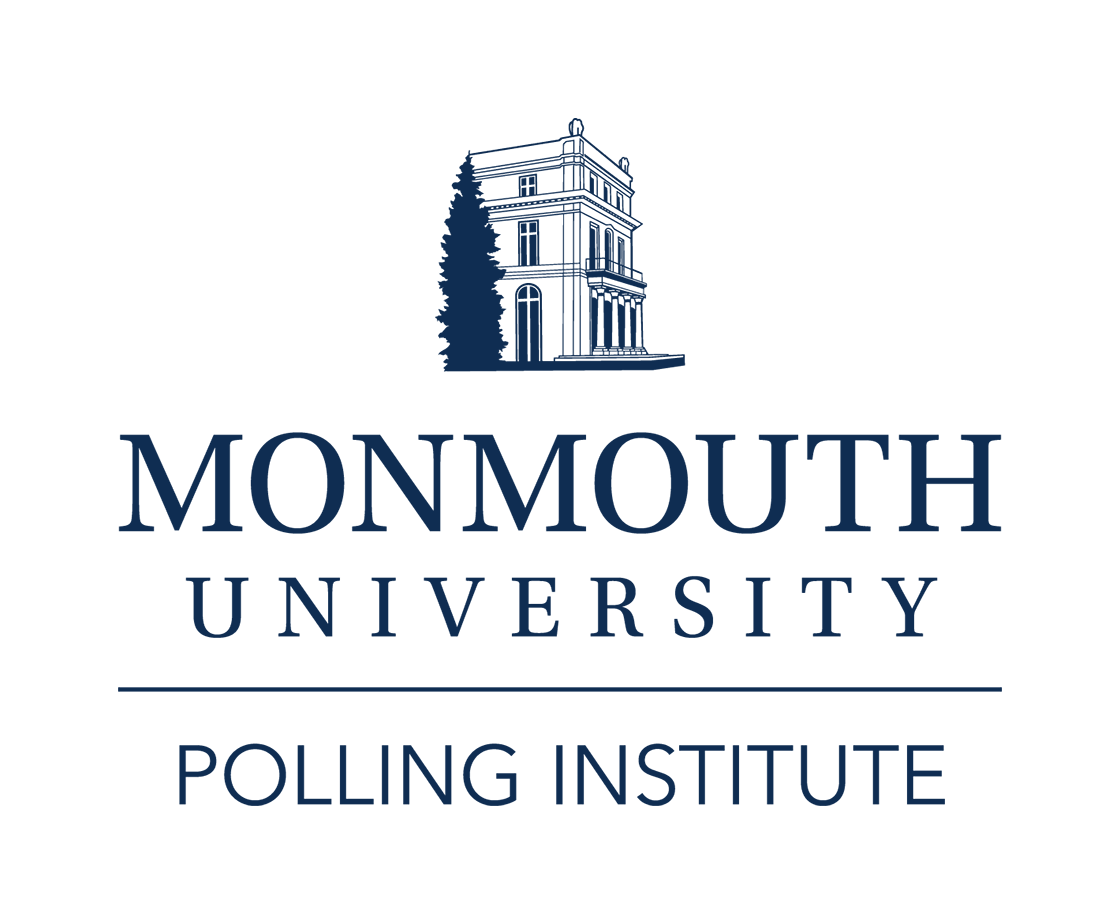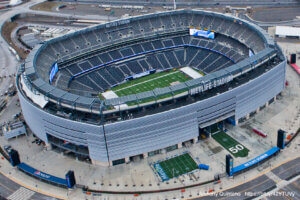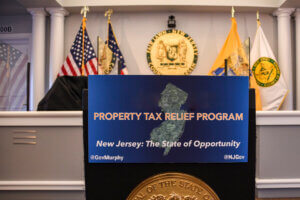New Jersey has had a split identity ever since Lord Berkeley and Sir George Carteret divided the new colony into east and west in the late 1600s. More than 300 years later, the state is still a tale of two Jerseys, with the more populous northern portion geared toward New York City and the southern half tuned into Philadelphia – Ben Franklin’s “barrel tapped at both ends.”
Do these regional identities mean anything? Well, according to the latest Monmouth University/Gannett New Jersey Poll , if you’re from North Jersey, it means very little. However, if you’re from South Jersey, it means a great deal. When asked whether government spending and programs are distributed fairly across the Garden State or if a certain region is favored, state residents give the edge to the north. About 1-in-3 (33%) say that North Jersey gets more than its fair share of resources. Only 10% feel South Jersey benefits more than it should from public programs. Another 21% feel that aid is divided equitably across both regions and 35% have no opinion.
The poll also found that how you see this issue depends on where you live. Northern residents are split – 21% say that both regions get their fair share, 22% say the north gets more, and 16% say the south gets more. On the other hand, a majority (56%) of South Jersey residents feel that their northern neighbors get more than their fair share of government largesse, compared to just 6% who feel the south makes out on the deal, and another 19% who say it is divided fairly. Central Jersey residents tend to side with the south, although not as emphatically – 32% say the north gets more than it should, 5% say the south is the greater beneficiary, and 18% say both regions are treated fairly.
Another interesting point is that North (41%) and Central (44%) Jersey residents are more than twice as likely as those who live in South Jersey (19%) to express no opinion on regional equity.
“South Jersey is the state’s Rodney Dangerfield. The perception of being slighted is part and parcel of South Jersey’s identity. On the other hand, regional identity doesn’t even seem to be a concern for the rest of the state, which, of course, only further irks South Jerseyans,” said Patrick Murray, director of the Monmouth University Polling Institute. [Full disclosure: Murray grew up in Camden County and now lives in the New Brunswick area.]
One enduring difficulty with understanding New Jersey’s regional tension is that no one seems to agree on where the northern half ends and the southern half begins. The poll found that, perhaps not surprisingly, the imaginary border between north and south depends on one’s own geographic vantage point. And this dividing line is further muddied by the fact that some residents insist that a third region called Central Jersey lies somewhere between the two extremes.
The poll asked residents to place 10 of the state’s towns in either North Jersey or South Jersey. Pollsters selected towns that straddle the colonial-era line which originally divided the state, from Phillipsburg in the northwest to Long Beach Island in the southeast.
Among all New Jersey residents, New Brunswick is perceived to be the most northerly of the 10 “border” towns in the poll – 38% place it in North Jersey compared to 23% who say it is in South Jersey. However, another 34% reject the north/south dichotomy offered by the poll and instead place the “Hub City” in Central Jersey. Another town which is seen as nominally more northern than the others is Somerville – 32% place it in the north, 25% in the south, and 22% in the central part of the state.
New Jerseyans are split on locating Flemington – 29% say it is in the north and 33% place it in the south, with another 17% who volunteer Central Jersey as its region. There is similar disagreement over Phillipsburg – 28% place this town in the north while a similar 24% say it is in the south. Just 8% would put P’burg in Central Jersey, but another 4-in-10 residents (41%) are not familiar enough with the town – the most northerly in the poll in terms of actual geography – to place it anywhere.
Another four towns in the poll are perceived as being in South Jersey by a plurality of New Jerseyans. These include Princeton (43% south, 29% central, 20% north), Red Bank (46% south, 19% central, 20% north), Trenton (49% south, 28% central, 19% north), and Lambertville (29% south, 17% central, 14% north).
A majority of New Jerseyans are able to assign only the Ocean County communities of Long Beach Island and Toms River to a single region. Two-thirds (67%) of state residents place each of these two towns decidedly in South Jersey.
|
Match the Town to its Region The prevailing opinion among… | ||||
|
|
All New Jerseyans |
North Jerseyans |
Central Jerseyans |
South Jerseyans |
| New Brunswick |
North (38%) Central (34%) |
Central (38%) South (36%) |
Central (51%) |
North (71%) |
| Somerville |
North (32%) |
South (33%) Central (27%) |
North (49%) |
North (41%) |
| Phillipsburg |
North (28%) South (24%) |
South (35%) |
North (34%) |
North (39%) |
| Flemington |
South (33%) North (29%) |
South (45%) |
North (37%) |
North (40%) |
| Lambertville |
South (29%) |
South (38%) |
Central (30%) South (27%) |
North (23%) Central (21%) |
| Princeton |
South (43%) |
South (62%) |
Central (46%) |
North (40%) |
| Red Bank |
South (46%) |
South (68%) |
South (44%) |
North (41%) |
| Trenton |
South (49%) |
South (69%) |
South (49%) |
North (40%) Central (40%) |
| Long Beach Island |
South (67%) |
South (73%) |
South (70%) |
South (55%) |
| Toms River |
South (67%) |
South (77%) |
South (73%) |
South (49%) |
“New Jersey has been a land divided since the colonial period, but the division line between East and West Jersey, or more recently north and south, remains a puzzle. We tend to see ourselves in relation to either New York City or Philadelphia, and this is reflected in the different language, food, and sports team affiliation that bind us together in our New Jersey identity,” said Richard Veit, associate professor of anthropology at Monmouth University and author of Digging New Jersey’s Past: Historical Archaeology in the Garden State .
Poll director Murray added, “It’s less a dividing line than a transitional zone called Central Jersey, which neither North Jersey nor South Jersey claims as their own.”
Of course, where these towns are perceived to be has a lot to do with where one lives. Residents of the state’s northernmost eight counties, traditionally considered North Jersey, tend to think of nearly all these towns as being in South Jersey. They hedge only on New Brunswick (36% say it is south and 38% central) and Somerville (33% south and 27% central), but no more than 1-in-5 North Jersey residents would place any of these 10 towns in their own region.
Not surprisingly, residents of the state’s southernmost eight counties, traditionally considered South Jersey, tend to consider most of these towns as being in North Jersey. This is especially true for New Brunswick (71% north). They waver somewhat on Lambertville (23% north, 21% central) and Trenton (40% north, 40% central), with equal numbers calling these two towns either north or central. The only two communities South Jerseyans clearly claim as their own are Toms River (49% south) and Long Beach Island (55% south).
Locating these towns gets even thornier when the poll isolates the responses of those who live in the five counties that make up the central “belt” of the state. Even though the poll only offered north and south as stated options, Central Jersey residents insist on placing New Brunswick (51% central) and Princeton (46% central) in their own region. They also split on Lambertville, with 30% putting it in Central Jersey and 27% in South Jersey.
Somerville (49% north), Flemington (37% north), and Phillipsburg (34% north) are seen as northern towns by a plurality of Central Jersey residents. On the other hand, Central Jerseyans tend to put Red Bank (44% south), Trenton (49% south), Long Beach Island (70% south), and Toms River (73% south) in South Jersey.
For the record, the Monmouth University Polling Institute uses the following county groupings to define New Jersey’s regions:
North – Bergen, Essex, Hudson, Morris, Passaic, Sussex, Union, Warren
Central – Hunterdon, Mercer, Middlesex, Monmouth, Somerset
South – Atlantic, Burlington, Camden, Cape May, Cumberland, Gloucester, Ocean, Salem
When poll respondents are asked to place their own hometowns in a region of the state, 40% select North Jersey, 35% Central Jersey and 23% South Jersey. Residents’ own sense of place lines up pretty well with the poll’s definition of region, with a few exceptions: in North Jersey, residents of Union County prefer to think of themselves as being in the central region; Hunterdon County residents are split between thinking of themselves as being in Central or North Jersey; and Ocean County residents’ sense of identity is divided between South and Central Jersey.
The Monmouth University/Gannett New Jersey Poll was conducted by telephone with 804 New Jersey adults from January 9 to 13, 2008. This sample has a margin of error of ± 3.5 percent. The poll was conducted by the Monmouth University Polling Institute and originally published by the Gannett New Jersey newspaper group (Asbury Park Press, Courier-Post, Courier News, Daily Journal, Daily Record, and Home News Tribune).
DATA TABLES
The questions referred to in this release are as follows:
(* Some columns may not add to 100% due to rounding.)
undefined. In your opinion, is the following town located in North or South Jersey, or haven’t you heard of it? [NOTE: THESE TOWNS WERE ASKED OF A RANDOM SUB-SAMPLE, moe=+/-5%]
|
NORTH | SOUTH | (VOL) CENTRAL | HAVEN’T HEARD OF TOWN | DON’T KNOW REGION |
Unwtd N | |
| New Brunswick |
38% | 23% | 34% | 2% |
4% |
345 |
| Somerville |
32% | 25% | 22% | 11% |
9% |
459 |
| Flemington |
29% | 33% | 17% | 9% |
12% |
345 |
| Phillipsburg |
28% | 24% | 8% | 28% |
13% |
459 |
| Princeton |
20% | 43% | 29% | 2% |
6% |
459 |
| Red Bank |
20% | 46% | 19% | 6% |
9% |
345 |
| Trenton |
19% | 49% | 28% | 2% |
3% |
345 |
| Lambertville |
14% | 29% | 17% | 28% |
11% |
459 |
| Long Beach Island |
14% | 67% | 7% | 6% |
6% |
345 |
| Toms River |
10% | 67% | 14% | 3% |
6% |
459 |
2. And do you call where you live North, Central, or South Jersey?
|
TOTAL |
by Monmouth | |||||
|
North | Central |
South | ||||
| North Jersey |
40% | 77% | 11% |
5% | ||
| Central Jersey |
35% | 20% | 83% |
17% | ||
| South Jersey |
23% | 2% | 5% |
77% | ||
| (VOL) Don’t know |
2% | 1% | 2% |
1% | ||
| Unwtd N |
804 | 353 | 208 |
206 | ||
3. Thinking about government spending and programs, do you think all regions of New Jersey get a fair share of state resources, or do you think North or South Jersey gets more than its fair share?
|
TOTAL |
by Monmouth | |||||
|
North | Central |
South | ||||
| All regions get fair share |
21% | 21% | 18% |
19% | ||
| NORTH Jersey gets more |
33% | 22% | 32% |
56% | ||
| SOUTH Jersey gets more |
10% | 16% | 5% |
6% | ||
| (VOL) Don’t know |
35% | 41% | 44% |
19% | ||
| Unwtd N |
804 | 353 | 208 |
206 | ||
The Monmouth University/Gannett New Jersey Poll was conducted and analyzed by the Monmouth University Polling Institute research staff. The telephone interviews were collected by Braun Research on January 9-13, 2008 with a statewide random sample of 804 adult residents. For results based on the total sample, one can say with 95% confidence that the error attributable to sampling has a maximum margin of plus or minus 3.5 percentage points. Sampling error increases as the sample size decreases, so statements based on various population subgroups, such as separate figures reported by gender or party identification, are subject to more error than are statements based on the total sample. In addition to sampling error, one should bear in mind that question wording and practical difficulties in conducting surveys can introduce error or bias into the findings of opinion polls.
It is the Monmouth University Polling Institute’s policy to conduct surveys of all adult New Jersey residents, including voters and non-voters, on issues which affect the state. Specific voter surveys are conducted when appropriate during election cycles.
Click on pdf file link below for full methodology and results by key demographic groups.




